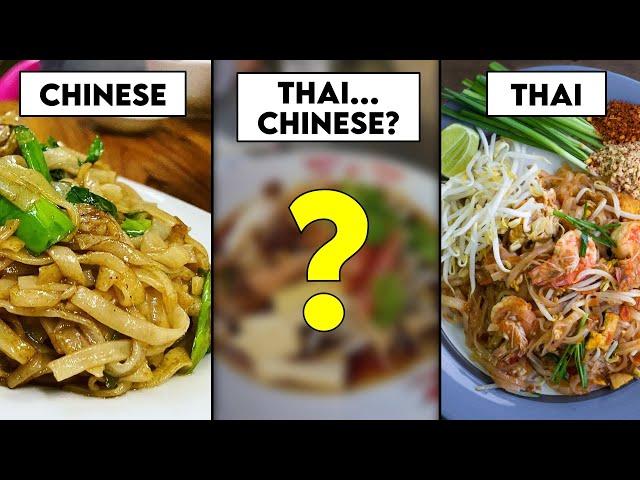
What is Thai-Chinese food? The case of Olive Pork.
Комментарии:

This is amazing. As a Thai who cooks, this is exactly what I would do for the Thai version. Great job. Great video!
Ответить
Love the research and there's alot of truth to what was presented. But actually it is quite common thru South East Asia. Some other dialects are The fujian in surabaya Indonesia and Penang in Malaysia. The fuzhou in Malaysia sarawak, Perak and Johor, and Bakmi in Indonesia is actually Chinese style noodles that's like a national dish now.
Ответить
I am Thai and I'm happy to see that our food culture diversity getting more recognition. I recommend you to try 'Curry Crab' or 'Poo Phad Phong Karee' it's a Thai-Chinese dish which is extremely delicious with rice :)
Ответить
The plain rice porridge with salty and preserved foods, even fatty ones are what I immediately associate as Teochew food (in Malaysia). Definitely an acquired style of eating that I'm fortunate to have learnt from my mom albiet us being Hokkein and Hainan. It's nice to still be able to identify a bunch of Chinese dishes by the Chinese regions from where I'm from. It would be so lovely if you guys came to Malaysia to find out about Chinese Muslim food since it's probably still quite intact, mee tarik and the likes (but be wary if the localised and chain restaurants ones).
Ответить
Thai (Chinese Teochew) here. Teochew might have arrived in Thailand for a very long time ago but there are a lot of them that arrive just around the cold wars like my family. My grandfather and grandmother are the first generation settling in Thailand from China. Thier parents couldn't make it in time, so they stuck behind the bamboo curtain. There was an exodus from Shantou around that time due to the mass starvation in Southern China during that time. (I have no citation to provide, this is the story from my grandmother.) No matter how hard they worked, they cannot earn enough to live another day, so my grandpa and grandma decided to immigrate to Thailand which at that time open for immigrants. All of our family eventually got Thai citizenship, but we had to go through Thai-ization + Red Scare which they have to abandon their Chinese name and last name, Lin. Their Chinese name became their Thai Nickname instead (most Thai have nickname since Thai first name is usually way too long). My dad still pissed regarding the racism toward Chinese people... forced changing name, closing Chinese primary school...etc. When I was a kid, my dad told me that when filling any forms, if they asked for ethic, do no filled as Chinese but filled as Thai instead, eventho I have like 90+% (if not 100%) of Chinese blood, since they were fear of racism from authorities.
One thing I found weird is during the cold war, there was a red scare sentiment from Thai Authorities, fearing us Chinese immigrant becoming communist rebels/spy. The truth is we, people from Shantou, have first-hand experience of revolution back in Shantou. Our family back in Shantou were starving to death. We have to work hard and send back money to our family in Shantou through Hong Kong / Singapore. At that time eventho my family were still broke AF, they all applied for Thai Passport. They feared that Thailand might got a domino effect and turned into communist state, so they can leave Thailand as soon as Thailand falls under communism. LOL.

I grew up in Chinatown in Bangkok, pork and olive is like our hamburger, but on't touch on the Sri-racha source man, it can get really controversial!
Ответить
Good video! Btw I think Padthai itself is kind of fusion food already. I'm not sure how it originated but it was heavily promoted by the dictator you mentioned in the video to represent the "Thai value" for people in the city especially the middle class which was growing during the revolution period. Before that we had something like noble food and peasant food Both mostly consisted of steamed or fresh veggie and fish together with various types of dipping paste. And after the modernization of government and military, we started to have a group of middle class together with all foreign traders and Chinese restaurants (and also western style restuarant) that were considered to be exotic luxury food for these new middle class. Padthai came after that and it was the fast food for these middle class lunch break.
Ответить
Damnit. That was some great history. Nice work! It is so hard to get the history of Chinese immigrants. Nobody recorded their story. I imagine most of the immigrants thought they would eventually return to Guangzhou. Maybe even that their second generation would return after making money. Much of that is lost to time.
Ответить
Yummmmmmm
Ответить
Wow love this video!
Ответить
I wish you can do this for Cambodian/Vietnamese food... a lot of intermixing of culture and food....
Ответить
Thai Chinese Food Culture is from Thai National People of Chinese Descent. Infact Thai Food is influenced by Indian culture,Tai culture,Chinese culture,Persian culture,Japanese-Korean culture,European culture.
Ответить
I really liked the mixture of history, culture, and of course food. Keep up the good work!
Ответить
Is that just me or does that plate at the end looks like a pretty amazing taco filling?
Ответить
General Phibun who made thainification he is chinese descent himself
Ответить
..lockdown of what?
Ответить
Kudos for the content. This is surprisingly educational in a good way.
Ответить
Excellent presentation. However, the original Tom Yum does not use cream of chili paste. It's a clear spicy soup accented with aroma of lemon grass and kaffir lime leaves. To add cream (or milk) is a modern version which (from my growing up) started to be popular in the late 70s. Addition of chili paste is certainly a Chinese influence started by Thai-cum-Chinese restaurants. In rural areas, the milk and chili paste version is not popular among locals. The 'hot' flavor comes from crushed fresh chili.
Ответить
Ha, I’m Chinese american, guess this is why I love Thai food; and we have americhinese food like orange chicken here.
Ответить
I was wondering who the Chaozhou people were until you mentioned Teochew, that's a much more common spelling here in SEA
Ответить
What’s the deal with frying the skins of the garlic cloves?
Ответить
couldn't you have reviewed the two dishes you made? i was dying to see the difference!
Ответить
There is a resturant down a soi behind the grand palace in Bangkok, the sign just says "Thai Shophouse Food" A lot of the dishes you would recognize as Thai street food. But they have a dish on the menu called "Chinese Style Pad Thai" It is a very similar dish to what we would consider a classic pad Thai, but this has no meat in it and a lot of cabbage. It's one of those things I had never seen in Thailand, nor had my wife who grew up here. This video made me think back to this dish, it was a pleasantly light surprise on a hot day we were out shooting at the palace. Thanks for a great video.
Ответить
Ok so that Chachaatang spaghetti is vwry good. 10/10 ~US
Ответить
Wow that's an insane amount of garlic. If it's really as antibacterial as my aunties claim, no microbes gonna habitate your body after that
Ответить
My Dad and his side of the family is Hokkien (Xiamen) Chinese-Filipino and some of these foods are so familiar, especially that grainy rice porridge. Put some pork floss and preserved duck egg in there and we're good!
Ответить
Thai Chinese..
Thainese?

Where can I buy Wulan (dried chinese black olive) or the tinned brine one in the USA?
( especially around Forth Worth, Texas area)
I’ve be craving “Nam Lieap Moo Sab” for years and try to find ‘Nam lieap’ everywhere both online and H mart or local asian grocery but they all don’t have them (they don’t even know about it 😭😭😭).
Please tell me where to buy them I would be so thankful 🥺 thank you 🙏

🥣🐷
Ответить
Pad see ew is similar to Ho Fun and actually taste similar to Ho Fun.
Ответить
Hi guys
Is there an email address I can contact you? Im currently working on a research and i think you could really help
Regards

Thai cuisine is like Chinese. But made better lol
Ответить
Jesus cooking Christ! You got the term all wrong. It's gotta be Chinese-Thai. It's gotta be ORIGIN-CURRENT RESIDENCY. You must be referring to Thais who are or whose ancestors were originally from China. Thai-Chinese is as ludicrous as American-Chinese. Please get your sheet together.
Ответить
In the past, such types of food were typically cooked by Thai-Chinese families. It's quite obviosly by the look of the chefs, but no one would label it strictly as 'Chinese food' since they are technically Thai. If you have a Thai ID, you are considered Thai, and there aren't any special benefits based on ethnicity. However, deep down, most people recognize the origins of certain foods from China, yet they tend to neglect or avoid acknowledging it cause there are many other adepation from other sources so why bother? such as Chicken Biryani or Khao Mok Kai are normally cook by Thai Muslim or The Roti are cooked by Thai-Indian.
Interestingly, the largest minority in Thailand isn't Chinese but Laotian. Thailand isn't a country dominated by one particular ethnic group; it comprises many and mixed over genernations, and all of them have had to adapt to live together. Most have been adapting for hundreds of years. Even among the Tai peoples, it's reasonable to expect the Chinese to assimilate, and fortunately, they did, mainly due to similarities in religion and seniority it wouldnt be that hard. I'm referring to the old Chinese culture before the Cultural Revolution not really sure about the modern Chinese.
PS. Nowadays in Bangkok many restaurants no longer hired Thai chef, not that they dont want to but cooking is a hard work and Thai people if they have a better choice they wouldnt do it unless it paid well so there are neigboring worker who ready to work for less money than Thai snf they just learn how to cook whatever food the boss order them to do recently, that worker are mainly from Myanmar. The food taste totally unstable, there was a time when it taste horrible in most pla es but it got better now cause the new low cost chef already got some skill.

I always thought “deijiu” was how you say teochew, in teochew.
Ответить
Im thai and this video is great. Keep it coming!
Ответить
Maybe another word for Jews of the Orient you described would be Middleman Minority, maybe you've heard of it before? Anyway, the olive pork is actually looking pretty tasty & straightforward
Ответить
And the darkest and funniest I found in the history of assimilation that the guy(pibulsongkram) who enforced the assimilation is also of chinese
Ответить
As a Chinese American living in Chiang Mai, I've been surprised to learn much of what I love and thought was quintesentially Thai food such as Pad See Ew and Roast Pork with stir fried Gai Lan are really Chinese dishes. Especially here in the north, that popular style of food is more is the curries and papaya salads and less the Thai Chinese food found in Bangkok.
Ответить
Pad Thai was derived from Cha Kuey Teow. The only different is Cha Kuey Teow don't have Tamarin sauce and it's not as hard on your stomach as Pad Thai. By all mean, Pad See Iw is not Cha Kuey Teow because most Cha Kuey Teow have bean sprouts.
Ответить
Great video going into the historical background and how it shaped the cuisine.. I always wondered why some thai restaurants had food that were chinese forward, and others were straight thai food.
Ответить
MACAU MENTIONED RAHHHHHHH 🇲🇴🇲🇴🇲🇴🇲🇴🇲🇴🇲🇴🇲🇴🇲🇴🇲🇴
Ответить
are the skins of the garlic thinner over there i noticed you didn't peel them and i've never done that before
Ответить

























